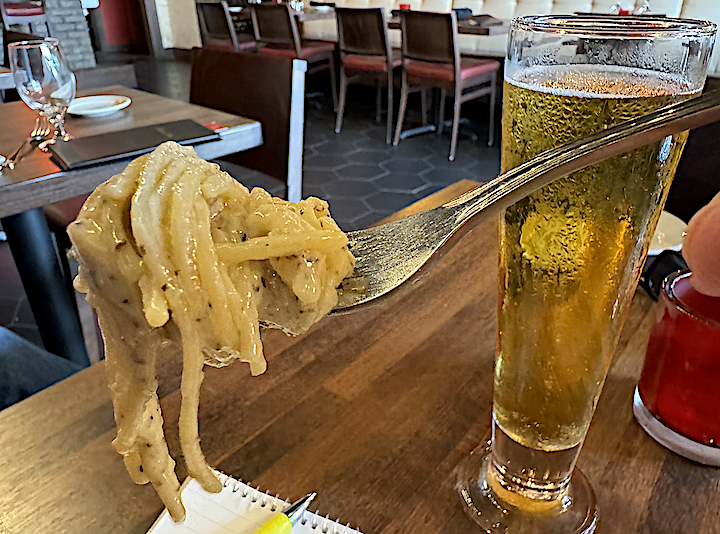We were visiting my daughter in Atlanta last month, chopping up ideas for future Friday Food Fights, when she said, “You should do cacio e pepe.”
I gave her a quizzical look. Maybe I’d not been perusing menus closely enough, or maybe I’d just been out to lunch, but I’d never heard of cacio e pepe.
Some of you might not have either. Here’s the short-and-simple: Cacio e pepe is an Italian pasta dish made with (usually) spaghetti, olive oil, black pepper and Pecorino Romano cheese. There are variations, of course.
Sure enough, I found the dish on a few online menus. I chose two Italian restaurants: Jay Luigi, on 4th Street in St. Pete, and Matteo Trattoria & Pizzeria in the city’s Grand Central district.
JAY LUIGI
6 p.m. Tuesday, predictably toasty. The would-be storm clouds over Jay Luigi turned out to be a tease. All the tables in the small dining room were occupied. Bonnie and I tried the outdoor patio, but it was too hot. We considered takeout. Then a booth opened up. The other three in our party, including a 3-year-old, joined us and crowded in.
Jay Luigi is a fast-casual place where you order at the counter and pay, and then servers bring the meal to the table. I ordered Cacio e Pepe ($15) and a bottle of Yuengling ($5.50) in a chilled glass.
Peyton, who I assumed was the manager, was very attentive — to us and everyone else. If I owned a restaurant — which I never have and never will — I would be thrilled to have him on my staff. This cat cared.
Appearance
Cacio e Pepe is not a dish you order for the color. Photos I looked at showed more black pepper than this version, although flecks were visible here. And most versions don’t have a pile of finely shaved cheese on top, but it did add a smidgen of flair to this one.
Texture and Taste
I’ve never had good spaghetti-twirling skills, which is partly the reason why I prefer other pastas. This plate of cacio e pepe made for some hard twirling. Jay Luigi’s recipe included a modest portion of panko crumbs, which had a thickening effect.
The dish was not quite gummy, but it certainly wasn’t moist. Jay Luigi uses Grana Padano cheese, which I assume is an upgrade from Romano. It was smooth, but didn’t make a strong flavor impression. The shaved stuff on top melted into globs. The black pepper added a modicum of spicy heat.
About two-thirds of the way through, I ditched the twirls and went to the fork chop.
MATTEO TRATTORIA & PIZZERIA
Our same quintet of diners showed up here at 5:45 on Wednesday. With the sun in full bore, eating outside was an absolute no go.
The interior is tastefully appointed, not fussy. Only a few tables were occupied, along with some bar patrons. The contemporary dance music coming from the sound system was a shade too loud.
Our server, a young woman, was aloof and appeared allergic to smiling. I ordered my Cacio e Pepe ($21) with a Peroni draft ($7).
Appearance
Not terribly appetizing. Whereas the Jay Luigi version looked dry, this one looked soupy. The flecks a black pepper were more obvious.
Texture and Taste
Matteo uses house-made tonnarelli pasta, which is thicker than spaghetti, although I couldn’t tell the difference — mostly because the cacio de roma cheese sauce was so dominant. There was more more black pepper in this dish than in Jay Luigi’s, but I couldn’t detect any of the spicy heat I’d hoped for.
Matteo’s cacio e pepe made for easier twirling, and the first few bites were fine. But as I continued to twirl and bite, the dish became heavy. Then heavier. It was simply too rich for my liking. I tapped out about halfway through, and didn’t ask for a go box.
And the Winner of the Curious Case of Cacio e Pepe Is …
Jay Luigi.
But the decision is mostly by default, because I didn’t find much to like about either. As a cacio e pepe rookie, my guess is that there are good versions to be had in local restaurants, but I’m not going to seek them out.
Cacio e pepe just isn’t in my culinary wheelhouse.
I did find it interesting, however, that the two versions I put into the ring for FFF were so vastly different in texture, if not flavor.










